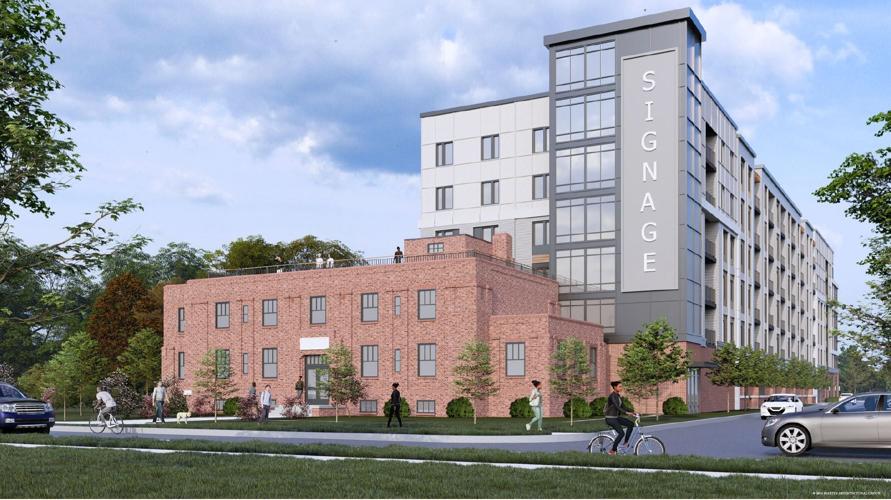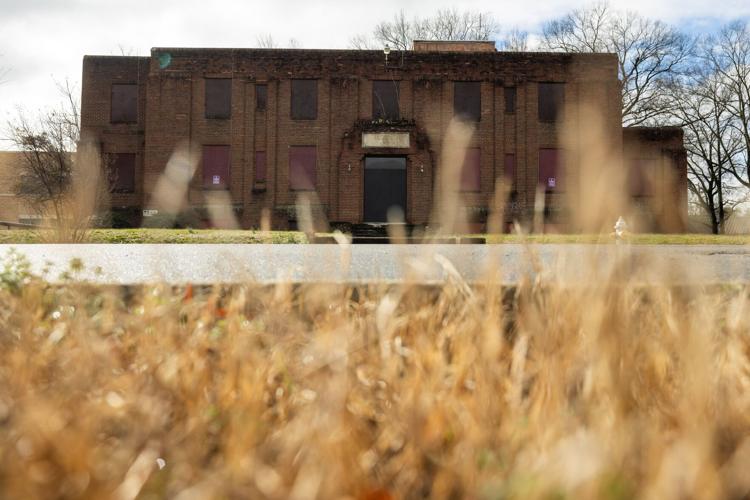Virginia Union University reversed course this week, saying it would fully preserve the old Richmond Community Hospital.
Ever since the university announced in February that it planned to tear down the historic but long-abandoned building, members of the community fought to save it. Now, their efforts appear to have been successful. The university has scaled down its redevelopment project and moved a planned apartment building off the Overbrook Road hospital site.
“We have listened closely as the community has spoken throughout the year,” said Hakim Lucas, president of Virginia Union.
People are also reading…

Virginia Union plans to fully preserve Richmond Community Hospital, which will be connected to a residential building.
But community members remain skeptical. A former city councilor filed a lawsuit Tuesday, hours before VUU made its announcement, in an effort to preserve the building.
The controversy began in early 2024, when VUU said it would partner with a New York investor to build up to 200 general-use residences along the north edge of VUU’s campus. Construction would involve tearing down a historic Black-owned hospital.
Black leaders raised money to construct the two-story art deco building in the 1930s despite the racist and segregated community in which they lived. In Richmond, property owners can demolish their buildings unless the parcel is designated Old and Historic. While VUU’s Belgian Friendship Building and Vann Memorial Tower have that designation, the hospital does not.

Residents quickly mobilized, saying the building should be preserved, even though it had been unused for decades. In August, VUU made an effort to compromise, saying it would preserve the hospital’s façade. Unsatisfied, preservationists continued to ask for the building to remain in full.
Then on Tuesday, the university turned 180 degrees, preserving the hospital, reducing the project’s size and increasing amenities such as a workout facility.
“People have acknowledged Richmond’s need for more housing options, while also wishing to protect the character of neighborhoods and expand amenities,” Lucas said. “This plan accomplishes all of these goals.”
Throughout the city, leaders have sought to balance a need for more housing with a desire to preserve Richmond’s character and history. To preserve the hospital, VUU reduced the number of apartments by 15%, which also reduces the space need for parking.
That means VUU will make less money on the project, the school said in a release. The decision to cut profits was made to expand the development’s “social impact.”
Richmond Community Hospital first opened in the 1900s in Jackson Ward. It moved to Overbrook Road in the city’s North Side in 1932 and to its current location in Church Hill in 1980.

Richmond Community Hospital moved to Overbrook Road in the city's North Side in 1932 and stayed there until 1980.
Most old buildings can be preserved, but often at a high cost, Marc Wagner, an architectural historian for the Virginia Department of Historic Resources, said earlier this year. Developers who preserve historic structures can receive federal and state tax credits that significantly reduce a project’s tax burden. VUU said it will seek grants and public funding to help cover the cost of renovation.
One member of the community expressed skepticism that VUU would follow through with its announcement.
“The devil is in the details,” said Viola Baskerville, a former Richmond City Council member, state delegate and Cabinet secretary in Gov. Tim Kaine’s administration. “Unless there is open communication and transparency with clear above-board discussions, and strong indications that the university has the financial capacity to carry out its promise, then these drawings are just nice renderings.”
Virginia Union’s announcement came hours after a former city councilor, Sa’ad El-Amin, filed a lawsuit in Richmond Circuit Court. El-Amin argued that when the hospital moved to Church Hill and gave its old property to the university, VUU became legally responsible for its upkeep. He also claimed that selling the property would violate the university’s nonprofit status.
A spokesperson for the university declined to comment on the suit.

At the eastern corner of Brook Road and North Lombardy Street, VUU plans to build 100 apartments and 10,000 square feet of retail space.
VUU’s development includes three residential buildings:
- At Brook and Lombardy, VUU intends to erect 100 apartments and 10,000 square feet of commercial space on a five-story building. The facility will have 50 parking spots. Virginia Union bought this former motel property in 2019.
- At 2410 Brook Road, VUU will build 73 units — two units fewer than originally planned. The size of the homes also has been reduced.
- At 1209 Overbrook Road, the site of the hospital, Virginia Union will build 96 units — 29 fewer than originally planned.
The university also said it will fill in vacant lots on the campus’s western edge, at 1831 Thomas St. and 1801 Rear Bath St. But it did not provide details.

At 2410 Brook Road, VUU will build 73 units, slightly fewer than originally proposed.
We sat down with the 5 candidates for Richmond mayor. Here's what they said.
Here's our five-part series highlighting the lives of each Richmond mayoral candidate, how they came to join the political arena and their dreams for the future of Richmond. Interviews were conducted at each candidate's favorite location in the city.
One of five candidates vying to be Richmond's mayor, Addison's campaign focuses heavily on education, public safety, economic growth and transparency — positions shaped by his childhood and government experience.
Michelle Mosby has relied on her past experience to promote her candidacy. Oftentimes, treating each outing as if it were a job interview.
The former head of the Richmond Henrico Health District built a platform in Richmond mayors race that focuses on affordable housing, education reform, government accountability and inclusivity.
Maurice Neblett is one of five candidates vying for the position of Richmond mayor in the Nov. 5 election. He is running on a platform that focuses heavily on community building, citizen engagement and dismantling barriers for those traditionally underserved.
Harrison Roday’s approach to government is a holdover from his days in the private sector: Utilize assets and maximize results.








![A1 Minute! October 22, 2024: New ‘Travelling Bricks’ exhibit; ‘Daughters’ documentary screening; Leaders of Impact campaign[A1]](https://bloximages.newyork1.vip.townnews.com/richmond.com/content/tncms/assets/v3/editorial/0/9a/09a9988f-44a9-52ef-974a-22977f5bbeb6/6717cfff3c46f.image.jpg?resize=150%2C84)















